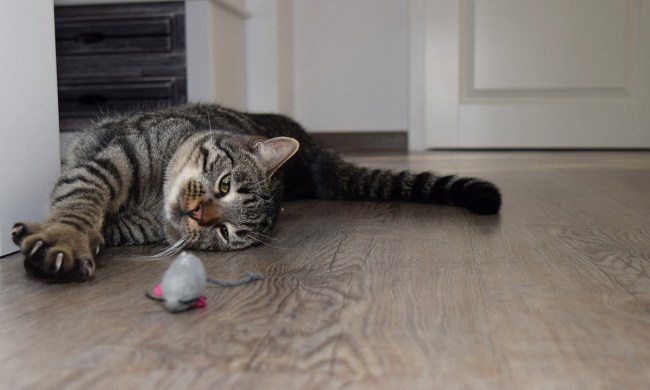A quality dry food can be an important staple of your indoor cat’s diet, but your cat’s food doesn’t have to be super expensive. In fact, you can find plenty of quality dry foods at many different price points. When choosing a dry food for your indoor cat, look for one that’s formulated specifically for indoor cats’ nutritional and weight management needs.
So what is the best dry food for indoor cats? There’s no one answer, and the best indoor cat food will be one that supports his unique nutritional needs. The following three options for the best dry foods for indoor cats are a good place to start, though.
Good: Rachael Ray Nutrish Indoor Complete Chicken with Lentils & Salmon Recipe Natural Dry Cat Food
The Rachael Ray Nutrish Indoor Complete dry cat food delivers a great value but is packed with quality ingredients, so you can feel good about feeding it to your cat. This chicken-with-lentils-and-salmon recipe features farm-raised chicken from right here in the U.S. as its first ingredient, so your cat will get plenty of protein. That chicken is combined with salmon for a protein-rich formula. To top things off, the blend of vitamins, minerals, and taurine gives your cat the well-balanced nutrition he needs. Lentils deliver fiber while supporting your indoor cat’s metabolism, and dandelion greens support your cat’s digestive health. Cranberries and blueberries are full of vitamins and minerals, while chicken meal contains omega-6 fatty acids that promote a healthy, shiny coat.
This food delivers all the nutrients your indoor cat needs to stay happy and healthy, but it also supports your cat’s metabolism to help keep him at a healthy weight. Chewy reviews noted that their cats “can’t get enough” of this food and called the formula “super enticing.”
Better: Purina Pro Plan Focus Adult Indoor Care Salmon & Rice Formula Dry Cat Food
The Purina Pro Plan Focus Adult Indoor Care dry cat food is designed just for indoor cats, helping them maintain a healthy weight. The high-protein formula features 42% protein to give your cat energy and stamina, and real salmon is the first ingredient. This food contains plenty of natural fiber for hairball control, while omega fatty acids promote a healthy coat and skin. Antioxidants also support your cat’s immune system, while vitamin A and taurine promote eye and vision health. This food is free of peas and is nutritionally balanced for your cat’s needs.
Chewy reviews noted that their cats loved the salmon formula, and even picky eaters cleaned their bowls.
Best: Wellness Complete Health Grain-Free Indoor Healthy Weight Chicken Recipe Dry Cat Food
Wellness Complete Health Grain-Free Indoor Healthy Weight dry food is packed with animal protein, feeding your cat the diet he would naturally consume in the wild. This grain-free chicken formula contains no corn, wheat, or soy. It’s free of artificial flavors, colors, preservatives, and meat byproducts. Its first ingredient is deboned chicken, and the formula contains 35% crude protein. Other natural ingredients include cranberries, potatoes, and flaxseed. This food is designed to satisfy your indoor cat’s hunger while also supporting his growth with nutritional supplements and nutrient-rich foods.
Chewy reviews noted that the food is highly appealing to cats, and it also helped with weight management.
Some premium cat foods can be seriously expensive, but it’s still possible to feed your cat a quality dry food without breaking the bank. By choosing the best-quality affordable dry cat food within your budget, you can support your indoor cat’s health in multiple ways. Fillers like soy and wheat can irritate sensitive digestive systems, while formulas that lack adequate protein can leave your kitty’s energy level and muscle development lacking. If you’re able to buy a quality food with plenty of protein and without fillers, you can promote overall health and an ideal weight in your indoor cat.


